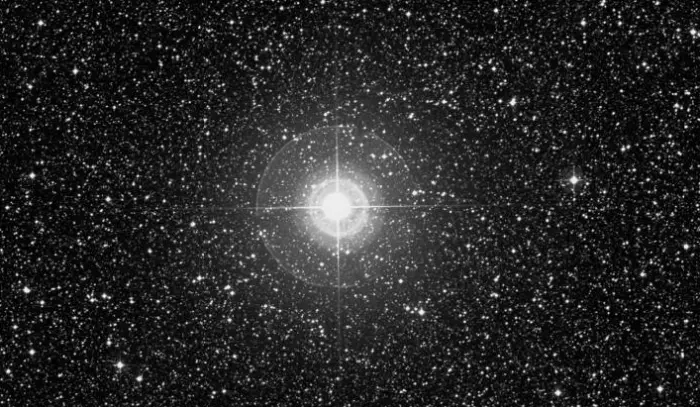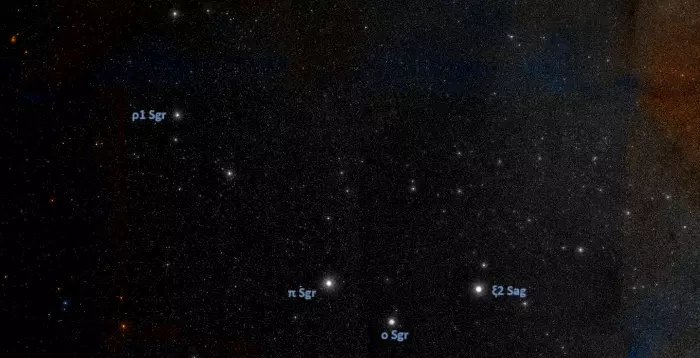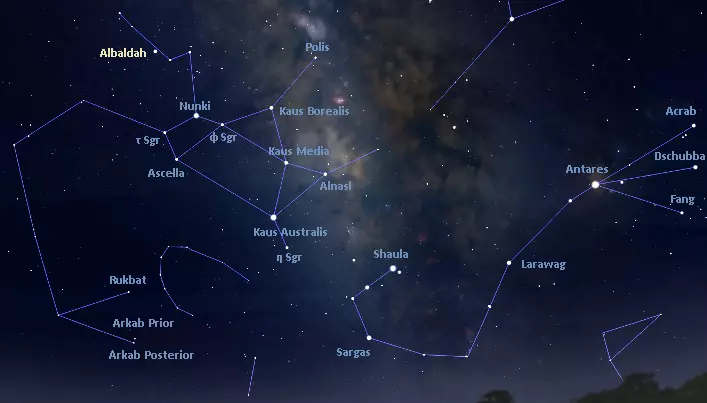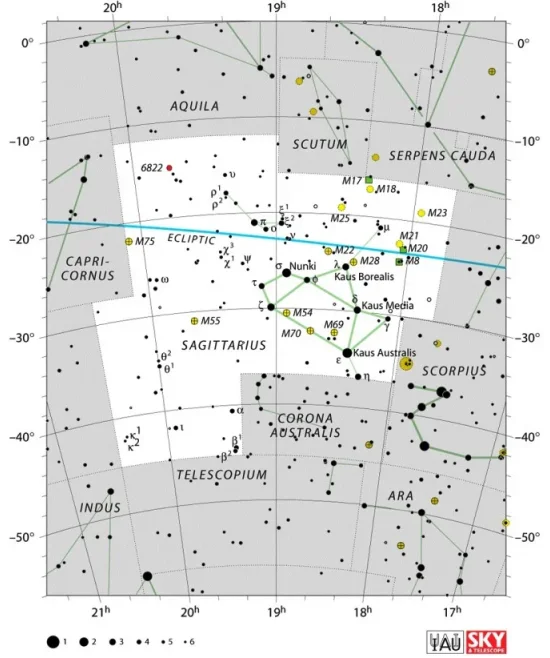Albaldah, Pi Sagittarii (π Sgr), is an F-type bright giant star located approximately 520 light-years away in the constellation Sagittarius. With an apparent magnitude of 2.89, it is the sixth brightest star in the constellation. It is part of a small asterism known as the Teaspoon, which lies next to the larger and brighter Teapot.
Star system
Albaldah has the stellar classification F2 II, indicating a white bright giant. Even though it is only 67 million years old, the star has burned through the supply of hydrogen in its core and evolved away from the main sequence quickly due to its high mass.
Albaldah is 5.9 times more massive than the Sun and has an effective temperature of around 6,590 K. It has a radius of about 28 solar radii and a luminosity of around 1,340 Suns. It spins at 30 km/s.

Albaldah (Pi Sagittarii), image: Wikisky
Albaldah started its life as a hot, blue, B-type main sequence star. While it is a massive star, it is not massive enough to end its life as a supernova. Instead, when it comes to the end of its life cycle, it will expel its outer layers to form a planetary nebula and slowly cool and fade as a white dwarf.
The star has two companions, one at a separation of only 0.1 arcseconds and another 0.4 arcseconds away. This corresponds to a physical separation of at least 13 astronomical units (AU) for the first companion and 40 AU or more for the second. The companions are designated Pi Sagittarii B and C. Their orbits and properties are unknown.
Facts
Albaldah lies only 1.43 degrees north of the ecliptic and can be occulted by the Moon and planets. However, it only gets occulted by planets rarely. The next occultation will be by Venus on February 17, 2035.
Albaldah forms the Teaspoon, a small asterism near the larger Teapot, with Rho1, Omicron, and Xi1 Sagittarii. For observers in the northern hemisphere, the Teaspoon appears to the upper left of the Teapot, near the Teapot’s handle.

The Teaspoon in Sagittarius, image: Wikisky
In ancient Mesopotamia, Albaldah may have formed an asterism known as Gu-shi-rab‑ba (“the Yoke of the Sea”) with the brighter Ascella (Zeta Sagittarii) and Nunki (Sigma Sagittarii).
Name
The name Albaldah (pronunciation: /ælˈbɔːldə/) is derived from the Arabic bálda or al baldah, meaning “the town” or “the city.” In Arabian astronomy, the City (commonly taken to refer to Mecca) was one of the 28 mansions of the Moon (stations of the Moon on its path along the ecliptic). The mansion was described as “the head of Sagittarius and his two locks.”
The name was approved by the International Astronomical Union’s (IAU) Working Group on Star Names (WGSN) on September 5, 2017. It formally applies only to Pi Sagittarii A, the primary component in the Pi Sagittarii system.
The 17th century Egyptian astronomer Al Achsasi al Mouakket listed Pi Sagittarii as Nir al Beldat, “the brightest of the town,” in his Calendarium. The name was later translated into Latin as Lucida Oppidi.
In Chinese astronomy, Albaldah was known as 建三 (Jiàn sān), the Third Star of Establishment. Establishment was an asterism formed by Albaldah with Xi2 Sagittarii, Omicron Sagittarii, 43 Sagittarii, Rho1 Sagittarii, and Upsilon Sagittarii. It was part of the larger Dipper mansion, one of the northern mansions of the Black Tortoise.
Location
Albaldah is easy to find because it appears close to the Teapot, one of the most prominent asterisms in the southern night sky. It is the brightest star appearing on the imaginary line extended from Kaus Australis, the brightest star in Sagittarius, through Nunki, the constellation’s second brightest star.

The location of Albaldah, image: Stellarium
Constellation
Albaldah is located in the constellation of Sagittarius. The celestial Archer is one of the ancient 48 constellations catalogued by the astronomer Claudius Ptolemy of Alexandria in his Almagest in the 2nd century CE. Like all zodiac constellations, it lies on the ecliptic, the Sun’s apparent path across the sky.
Sagittarius occupies an area of 876 square degrees of the southern sky and is the 15th largest of the 88 constellations. It is one of the brighter southern constellations, with seven stars brighter than magnitude 3.0. The brightest stars in Sagittarius form an asterism called the Teapot. The asterism appears next to the Milky Way’s bright band. On a clear, dark night, the Milky Way appears as steam coming from the Teapot.
Sagittarius contains many notable stars. These include the hot blue giant Kaus Australis, the constellation’s brightest star, the hot B-type star Nunki, the luminous blue variable known as the Pistol Star (V4647 Sagittarii), the blue supergiant Polis, the red supergiants KW Sagittarii and VX Sagittarii, the Wolf-Rayet Star WR 104, the triple star system Zeta Sagittarii (Ascella), and the orange giants Kaus Media and Kaus Borealis.

Sagittarius constellation map by IAU and Sky&Telescope magazine
Located in the rich field of the Milky Way, Sagittarius hosts many bright and well-known deep sky objects, including more Messier objects than any other constellation. These include the Small Sagittarius Star Cloud (M24), the globular clusters Messier 22, Messier 28, Messier 54, Messier 55, Messier 69, Messier 70, and Messier 75, the open clusters Messier 18, Messier 21, Messier 23 and Messier 25, and the bright nebulae Messier 8 (the Lagoon Nebula), Messier 17 (the Omega Nebula), and Messier 20 (the Trifid Nebula).
Other deep sky objects in Sagittarius include Sagittarius A*, the Milky Way’s central black hole, the open clusters known as the Arches Cluster and the Quintuplet Cluster near the Galactic centre, the globular clusters NGC 6723 and NGC 6544, Barnard’s Galaxy, the Sagittarius Dwarf Elliptical Galaxy, the reflection nebula NGC 6589, and the planetary nebulae NGC 6565, NGC 6578, the Red Spider Nebula (NGC 6537), the Eye of Sauron Nebula (M 1-42), and the Little Gem Nebula (NGC 6818).
The best time of the year to see the stars and deep sky objects in Sagittarius is during the month of August, when the constellation appears higher above the horizon in the evening. The entire constellation is visible from locations south of the latitude 55° N.
The 10 brightest stars in Sagittarius are Kaus Australis (Epsilon Sgr, mag. 1.85), Nunki (Sigma Sgr, mag. 2.05), Ascella (Zeta Sgr, mag. 2.59), Kaus Media (Delta Sgr, mag. 2.70), Kaus Borealis (Lambda Sgr, mag. 2.82), Albaldah (Pi Sgr, mag. 2.89), Alnasl (Gamma² Sgr, mag. 2.98), Eta Sagittarii (mag. 3.11), Phi Sagittarii (mag. 3.17), and Tau Sagittarii (mag. 3.326).
Albaldah – Pi Sagittarii
| Spectral class | F2 II |
| U-B colour index | +0.22 |
| B-V colour index | 0.35 |
| Apparent magnitude | 2.89 |
| Absolute magnitude | -3.08 |
| Distance | 520 ± 20 light-years (160 ± 7 parsecs) |
| Parallax | 6.2410 ± 0.2868 mas |
| Radial velocity | -9.80 ± 0.74 km/s |
| Proper motion | RA: -1.36 ± 0.47 mas/yr |
| Dec.: -36.45 ± 0.31 mas/yr | |
| Mass | 5.9 ± 0.3 M☉ |
| Luminosity | ~ 1,340 L☉ |
| Radius | ~ 28 R☉ |
| Temperature | 6,590 ± 50 K |
| Age | 67 million years |
| Rotational velocity | 30 km/s |
| Surface gravity | 2.21 ± 0.05 cgs |
| Constellation | Sagittarius |
| Right ascension | 19h 09m 45.83293s |
| Declination | –21° 01′ 25.010335″ |
| Names and designations | Albaldah, Pi Sagittarii, π Sgr, 41 Sagittarii, HD 178524, HR 7264, HIP 94141, SAO 187756, FK5 720, BD−21° 5275, GC 26386, GCRV 11611, JP11 3078, PPM 269391, PLX 4462.00, IRAS 19067-2106, 2MASS J19094584-2101247, UBV 16239, IRC -20542, YZ 111 8120, TYC 6295-282-1, Gaia DR2 4082115215097592704, CCDM J19098-2101AB, IDS 19038-2111 ABC, WDS J19098-2101AB,C |